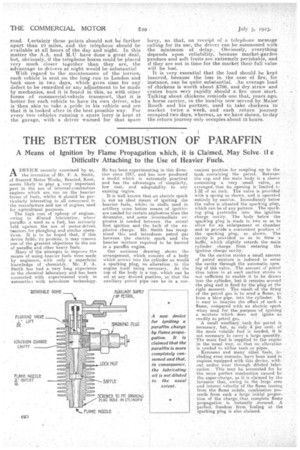THE BETTER COMBUSTION OF PARAFFIN
Page 10

If you've noticed an error in this article please click here to report it so we can fix it.
A Means of Ignition by Flame Propagation mhich, it is Claimed, May Solve, if e Difficulty Attaching to the Use of Heavier Fuels.
ADEVICE recently examined by us, the.invention of Mr. F: A. Smith,
of Brasted Motor Works, Brasted, Kent, seems likely to play 4, very important part in the use of internal-combustion engines which are run on the heavier forms of fuels, whilst it should be particularly interesting to all concerned, irt the manufacture and use of engines used. for agricultural purposes. The high cost id upkeep of engines, owing to diluted lubrication, where paraffin :s used as a fuel, has seriously told against the use of motor-driven tPactors for ploughing and similar operaticna. It i to be hoped that, if this device fulfil., its promise, it mayremove one of the greatest objections to the use of paraffin and other heavy fuels,
Many of -the attempts Co improve the means of using heavier fuels were made by engineers, with only a superficial knowledge of chemistry.. Mr. F. A. Smith has had a very long experience in the chemical laboratory andhas been connected wills experimental work in eonnectiou with betroleurn technology.
He has been experimenting in this direction since 1917, and has new produced a model -which is extremely practical and has the advantages of simplicity, low cost, and adaptability to any existing engine.
It is well known that an electric spark is not an ideal means of igniting the heavier fuels, whilst in shells used in artillery some better means of ignition are needed for certain explosives than the detonator, and _some . intermediate explosive is needed between the actual first ignition and the bulk of the 6X. _ plosive charge. Mr. Smith has recognixed this and introduces petrol gas between the electric spark and the heavier mixture required to be burned in a paraffin engine.
Our sectional drawing . shows the arrangement, which consists of a body which screws into the cylinder as would a sparking plug, no alteration to the engine itself being necessary, At the top of the body is a cap, which can be set at any desired position, so that the auxiliary petrol pipe can be in a con
venient position for couPling up to the
• tank containing the petrol. Between • the cap and the main body is a sleeve containing a very small .valve, so arranged, that its opening is limited to 1-32 of an inch. The valve is provided with a spring as shown, end is operated entirely by suction. Immediately below the valve -is situated the sparking plug, which can be of any pattern. The sparking plug protrudes into the ignition charge cavity. -The body below the sparking plug is made in two se as to allow for an enlargement or chamber and to provide a convenient position of the sparking plug, as, shown. The cavity. is provided so as to form u baffle, which" slightly retards the main cylinder charge from entering the ignition charge cavity.
On the suction stroke a small amount of petrol mixture is induced to enter the cavity through the automatic opening of the valve. -The amount of petrol thus taken' in at. each sixtieth Stroke is ti..rt sufficient to enable it to be drawn into the cylinder, but it remains around the plug and is fired by the plug at the right moment. The result of the firing of the petrol gas is to send' a flame, as from a blow-pipe, info. the 41inder. It is easy to imaoine the effect of s,uch flame, compared with an electric spark when used for the purpose of igniting a mist-are which does not ignite as readily as petrol gas.
A small auxiliary: tank ,for petrol is isecessary, bat, Only 4 Per cent, of, the, more volatile fuel is needed, it is
. not necessary to carry a large quantity. The main fuel is supplied to the engine in the usual way, so that no alteration is needed to either tank or pipes.
Kerosene and than Other fuels, in. chiding even creosote, have been Used in engines equipped with this device; without. undue wear through diluted lubrication. This may he accounted for by the more perfect combustion caused by the super-charge, as it is claimed by the .inventor that, owing to the large area and intense velocity of the flame issuing from the flame nozzle, combustion proceecla from such a large -initial proportion of the charge .that complete flame propagation is instantly ensured, . perfect freedom from fouling at the sparking plug is also claimed.














































